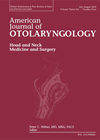
Journal Reviews
An otological cure for globus?
Globus pharyngeus is a common benign condition frequently encountered in ENT practice. Laryngopharyngeal reflux and psychological stressors are often considered to be contributory factors, but globus symptoms do not always respond to antacid medications. Such medications can also be limited...
Is pan-endoscopy necessary to detect synchronous primary in upper aerodigestive tract cancer?
Diagnosis of head and neck cancer requires speed. It has also to be comprehensive in view of the possibility of synchronous primary cancer (SPC) associated with upper aerodigestive tract cancer (UADTC). Some centres still consider pan-endoscopy essential in the diagnostic...
Which patients are suitable for surgery in recurrent head and neck cancer?
Currently, radiotherapy and chemotherapy is the most common modality used in the management of primary head and neck squamous cell carcinomas (HNSCC). Unfortunately, around 50% of patients experience disease recurrence (rHNSCC). Surgery is therefore often used as a salvage treatment....
Extranodal extension following surgical resection of HPV-positive oropharyngeal cancer – is adjuvant radiotherapy alone sufficient?
Human papillomavirus (HPV) is a known aetiological factor in oropharyngeal squamous cell carcinoma (OPSCC). HPV-positive OPSCC is recognised to have a more favourable prognosis than HPV-negative disease. Treatment deintensification for HPV+ OPSCC has therefore been an area of research focus...
Facial paralysis revisited
Facial paralysis grading is a confusing issue. Lots of classifications have been proposed but all are subjective. The authors attempted to automate the Sunnybrook Facial Grading System (SFGS) by training a convoluted neural network (CNN) deep learning system. They used...
What are the consequences of facial palsy on working life?
Facial palsy (FP) has multiple causes, including iatrogenic or idiopathic paralysis, trauma and tumours. Whilst for certain aetiologies, such as Bell’s palsy, recovery of function is expected, many patients will experience permanent symptoms due to incomplete recovery of the facial...
WRMD in otolaryngology
Work-related musculoskeletal disorders (WRMD) are now front and centre in the practice of otolaryngology head and neck surgery, with many surgeons suffering pain, disability and shortened career spans. Common WRMDs include degenerative lumbar spine disease, rotator cuff pathology, degenerative cervical...
Chin up, doc! A few simple manoeuvres could make all the difference in FNE
Flexible nasendoscopy (FNE) is an ENT surgeon’s bread and butter. It is integral and often considered superior to conventional radiography in the assessment of laryngeal and pharyngeal cancers. However, it is not as simple as sticking the camera in and...
IIb nodes in a node-negative neck
This is an 11-year retrospective study of 389 patients who underwent 527 supraomohyoid neck dissections in a clinically node-negative (cN0) neck between November 2012 and November 2023. Oropharyngeal, maxillary, gingival and maxillary sinus tumours, along with those with a location...
Not to be mis-underestimated
It is a very rare occurrence to find a paper looking at NF2 and the auditory system. There seems to only be a couple on NF2 prevalence in the population, so this is unsurprising. As far as I can recall...
Total glossectomy and laryngectomy
This review paper analysed studies published between January 2000 and January 2024, assessing the functional outcomes of total glossectomy combined with laryngectomy. The primary outcomes included speech ability, swallowing function and gastrostomy tube dependence. Secondary outcomes considered were disease recurrence...
Eagle syndrome and vascular complications
Eagle syndrome is characterised by an elongated styloid process, which is anatomically positioned between the external carotid artery laterally and the internal carotid artery and internal jugular vein medially. As a result, vessel impingement can be exacerbated by head movements,...















